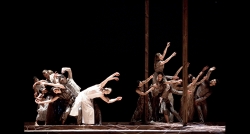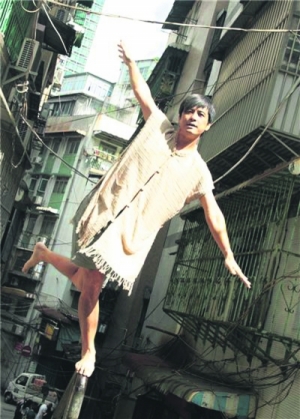 |
Noh theatre, one of the most traditional Japanese theatre arts, with its stylistic performance, has its history stretched all the way back to the 14th century. How to preserve this traditional treasure, and at the time renew the form to address to the contemporary audience will be a big challenge to any artists.
Toshio Hosokawa, the Japanese-borne German-based Composer, took this challenge by transforming one of the most famous Noh repertoires Matsukaze into a contemporary opera, with the German libretto written by Hannah Dubgen. He further collaborated with the Berlin’s dance icon Sasha Waltz, who is the Director and Choreographer of the piece.
Sasha Waltz, the Artistic Director of Sasha Waltz & Guests, started her artistic inquiry into the intermingling of music and dance in 2005 with her artistic creations of ‘Choreographic Operas’. Before Matsukaze, which was premiered in Brussels in 2011, she has already turned the famous Dido & Aeanas and Medea into choreographies. Waltz exclaimed that this work “marks the high point of my artistic research of the last ten years.”
Matsukaze is a simple story with the ever romantic theme of love transcending morality, love having no boundaries.
The story is about two sisters, Matsukaze (meaning Wind in the Pines) and Murasame (Autumn Rain), lived by the coast of Suma as the salt extractors, and loved the same nobleman Yukihira. After hearing the devastating news of his death after his departure, the sisters went into despair and died soon after. Yet their spirits still lingered to the mortal world and yearned for the reunion with Yukihira. A monk came by the seaside to discover their secrets and they asked him for the release of their souls.
Matsukaze – reference to tradition Noh theatre and symbolism of the work
The opera is divided into 5 acts following a prologue. This is reminiscent to the structure of the Noh theatre, which is also composed of 5 Noh plays.
A man clad in white wearing a white netted mask ran from the back of the theatre to the front of the stage, stretched his limbs out in space, reaching out in the air, performing rapid circles and jumps, dancing out his anxiety.
Masks in the Noh theatre tradition, are transformative devices for the same performer to change into a different character, mostly to women, old people or ghost / spirits. Here, right in the beginning, Waltz wanted to invite the audience to enter into the world of the unsettled spirit
Act I ‘Sea’ started with the recorded sounds of sea waves from the sea in Japan. Performers entered in single, in duos, in trios, all with their elegant and flexible bodies performed wavy movements that echoed the shapes of the tides or waves. Many times they faced the back, as if they are telling the story of the sisters reaching out to the dark old sea to wait for their beloved.
The audience could see not one, but two, sometimes more of the same characters of Matsukaze and Murasame. Yes, they all represented the sisters. Multiple characters represented by the same person is another notable technique in Noh, and Waltz engaged it not only as another reference to the tradition form, but also to represent the translucent nature of the spirits, creating the dreamy hallucinating world for the audience.
Miwako Handa performed Matsukaze and Jihee Kim as Murasame. Their beautiful singing along with their acting and dancing expressed well the longing for their love and the painful emotions within. With sometimes harmonious and sometimes conflicting singing, it delivered the message of the strong bond between the two sisters, yet at the same time, the envy, the jealousy towards the other when it came to the love for the same man. Yet could these two characters not represent the different sides of the same person; and could they not be the representation of both you and me?
The pine is a very important symbol in this work - the monk discovered the story of the sisters by a pine tree; the name of Matsukaze means ‘the wind of the Pine’ ("Matsu" in Japanese means "waiting for the soul of a god to descend from Heaven"). In the Asian culture, pine tree represents longevity, virtue and youth, and obviously represented the desired eternity of the relations between the sisters and their lost love. In traditional Noh theatre, a drawing of a pine tree is painted at the back wall of the stage, to create a sacred place where men are likely to encounter the spiritual voices of nature as they are in a temple or shine.
Apart from the pine tree symbol, the set design of the minimal wooden structure in Act III ‘Night’ also pays homage to the Noh theatre. It resembled the traditional Noh main stage, where four wooden pillars are constructed supporting a visible rooftop signifying the home of the mortals. In this creation, the rooftop is removed, the structure multiplied, stating clear the home which the sisters longed for returning was invisible; and the dances performed in each compartment to deliver the emotions of the internal struggles of the two frustrated sisters amplified by this multiplication.
Sasha Waltz – Mastery of Visualization
Sasha Waltz is a master of space and size, with many of her previous works performed in large-scale theatres, museums, outdoor and alternative spaces, and with her childhood influenced by her architect father and a gallery-owner mother.
In Matsukaze, the most notable and creative innovation is in the large-scale dark net-like installation stretching the whole proscenium in Act II ‘Salt’.
A dancer pulled the net structure out from the back of the stage to the very front, making visible the net structure as the complicated entanglement of internal emotions. The dancer then disappeared into the net. The lights dimmed. With the relighting of a dim yellow light at the top, signifying the moon, two sisters descended from above. Together with the singing and water sounds, the scene was beautifully constructed and ignited so many imaginations.
At one time, this is the dark blue sea where the sisters used to reside by, where they dived in and swam along (have they drowned themselves in desperation?); at another time, this is the psychological space of agony they were suffering from; yet still at another time, it is ‘the other world’ where the spirits entered, yet hanged in between, refusing to reach both ends.
A Valuable Experimentation
Matsukaze presents a valuable experimentation for both the Composer Hosokawa and the Choreographer Waltz, in their joint effort in transforming a historical Noh theatrical works into a Choreographic Opera.
Hosokawa once commented on Noh being old-fashioned and therefore intended to renew it into a contemporary opera, to provide new insights for the beauty of the traditional form.
He also commented that in traditional opera, the most movement singers will do is to stretch out their arms while singing; and therefore in this opera, all singers having to move with the performers, is certainly a great experimentation for the form.
Hosokawa also experimented with the composition of the music. Apart from the Japan wind bells, he tried to create all the Japanese sounds making use of only western instruments. He also especially emphasized on the silence between notes, comparing his music making with the writing of Japanese calligraphy (which he once practiced), playing with the density of the notes as one will in the strokes in calligraphy.
The work also provided a great experimentation for Waltz, in trying to relate to a form that is very distinct from her own culture. In researching for the opera, she even went all the way to Japan to understand the tradition Noh theatre form and to understand the place where the composer got the inspiration.
Although Waltz in Sasha Waltz: A Portrait (DVD) also exclaimed that she found an opera a fixed entity, one that “there’s a plot, a specific dramatic development that is determined by the text, by the libretto”. That limited her to work in a fragmented way and deprived her liberty to rearranging different parts like in her other works. And maybe because of this fact, even when Hosokawa aimed for this work to be religious, “an opera of purification of the soul”, and with the huge effort paid by both artists, and with the extraordinary visuals, Matsukaze seems not to have elevated to the level that could touch one’s soul.
本文章並不代表國際演藝評論家協會(香港分會)之立場;歡迎所評的劇團或劇作者回應,回應文章將置放於評論文章後。
本網站內一切內容之版權均屬國際演藝評論家協會(香港分會)及原作者所有,未經本會及/或原作者書面同意,不得轉載。
本網站內一切內容之版權均屬國際演藝評論家協會(香港分會)及原作者所有,未經本會及/或原作者書面同意,不得轉載。









